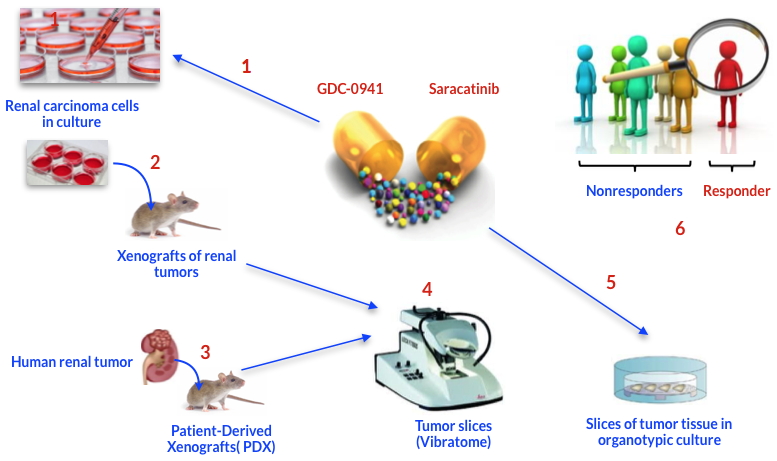The incidence and associated mortality of kidney cancer has increased in recent years. Clear Cell Renal Carcinoma (CRCC) is the most common renal cancer whose progression to the occurrence of metastases causes, in 25% of cases, a 5-year survival of less than 10%. Although the treatment of metastatic kidney cancer has undergone recent turmoil with the arrival of chemical molecules targeting protein kinases involved in angiogenesis, the real impact of these new therapies on survival remains modest. It is nevertheless established that the proliferation and survival of tumor cells rely on molecular pathways in which kinases are key players. It is therefore urgent to pursue in this direction in order to identify new therapeutic targets.
We have found that PI3K and Src protein kinases are overactivated in human kidney tumor samples. From this observation, we tested a combination of concentrations of the chemical molecules GDC-0941 and Saracatinib, respectively inhibiting PI3K and Src protein kinases. We performed these experiments on cells derived from a clear cell renal tumor, tissue sections (organotypic cultures) derived from xenografts of these cancer cells and finally models of tumors of patients transplanted in mice (PDX). The results show that the simultaneous inhibition of PI3K and Src protein kinases by these specific chemical inhibitors synergistically blocks the proliferation and invasion of cancerous kidney cells and causes their death by apoptosis.
Currently, clinical oncology highlights the search for predictive methods of a treatment called "à la carte", optimized for each patient, associated with strategies of combinatorial therapy. In this context, our study provides the first preclinical evidence for a rational use of this combination of inhibitors for the treatment of certain kidney cancers.

Combinations of PI3K (GDC-0941) and Src (Saracatinib) kinase inhibitory molecules are tested on renal carcinoma cells in culture
(1); tumor xenografts obtained after implantation in mice of renal carcinoma cells (2); xenografts obtained after implantation in mice of tumor fragments of patients (3);sections of 300 microns are made using a vibratome (4), and processed for organotypic cultures in the presence of chemical inhibitors (5). Evaluation of the cell viability of tumor sections after 72 hours of treatment makes it possible to classify patients as responders or non-responders (6).
Applied directly to samples from kidney tumor excisions, this method represents a quick way to define the most appropriate treatment for a patient
* Protein kinases are major components of signaling pathways that allow cells to respond appropriately to their environment.